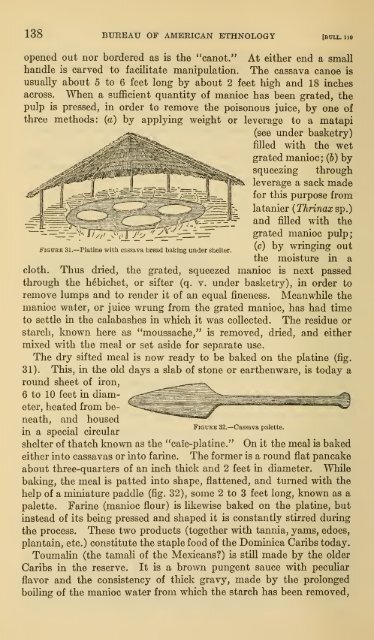Create successful ePaper yourself
Turn your PDF publications into a flip-book with our unique Google optimized e-Paper software.
138 BUREAU OF AMERICAN ETHNOLOGY [bull. 119<br />
opened out nor bordered as is the "canot." At either end a small<br />
handle is carved to facilitate manipulation. <strong>The</strong> cassava canoe is<br />
usually about 5 to 6 feet long by about 2 feet high and 18 inches<br />
across. When a suflBcient quantity <strong>of</strong> manioc has been grated, the<br />
pulp is pressed, in order to remove the poisonous juice, by one <strong>of</strong><br />
three methods: (a) by applying weight or leverage to a matapi<br />
(see under basketry)<br />
filled "with the wet<br />
grated manioc; (b) by<br />
squeezing through<br />
leverage a sack made<br />
for this purpose from<br />
FiGUEE 31.—Platine with cassava bread baking under shelter.<br />
latanier (Thrinax sp.)<br />
and filled with the<br />
grated manioc pulp;<br />
(c) by wringing out<br />
the moisture in a<br />
cloth. Thus dried, the grated, squeezed manioc is next passed<br />
through the hebichet, or sifter (q V. under basketry), in order to<br />
remove lumps and to render it <strong>of</strong> an equal fineness MeanwhUe the<br />
manioc water, or juice wrung from the grated manioc, has had time<br />
to settle in the calabashes in which it was collected. <strong>The</strong> residue or<br />
starch, loiown here as "moussache," is removed, dried, and either<br />
mixed with the meal or set aside for separate use.<br />
<strong>The</strong> dry sifted meal is now ready to be baked on the platine (fig.<br />
31). This, in the old days a slab <strong>of</strong> stone or earthenware, is today a<br />
round sheet <strong>of</strong> iron,<br />
6 to 10 feet in diameter,<br />
heated from beneath,<br />
and housed<br />
Figure 32.— Cassava palette.<br />
in a special circular<br />
shelter <strong>of</strong> thatch known as the "caie-platine." On it the meal is baked<br />
either into cassavas or into farine. <strong>The</strong> former is a round flat pancake<br />
about three-quarters <strong>of</strong> an inch thick and 2 feet in diameter. While<br />
baking, the meal is patted into shape, flattened, and turned with the<br />
help <strong>of</strong> a miniature paddle (fig. 32), some 2 to 3 feet long, known as a<br />
palette. Farine (manioc flour) is likewise baked on the platine, but<br />
instead <strong>of</strong> its being pressed and shaped it is constantly stirred during<br />
the process. <strong>The</strong>se two products (together with tannia, yams, edoes,<br />
plantain, etc.) constitute the staple food <strong>of</strong> the <strong>Dominica</strong> <strong>Caribs</strong> today.<br />
Toumalin (the tamali <strong>of</strong> the Mexicans?) is still made by the older<br />
<strong>Caribs</strong> in the reserve. It is a brown pungent sauce with peculiar<br />
flavor and the consistency <strong>of</strong> thick gravy, made by the prolonged<br />
boiling <strong>of</strong> the manioc water from which the starch has been removed,

















